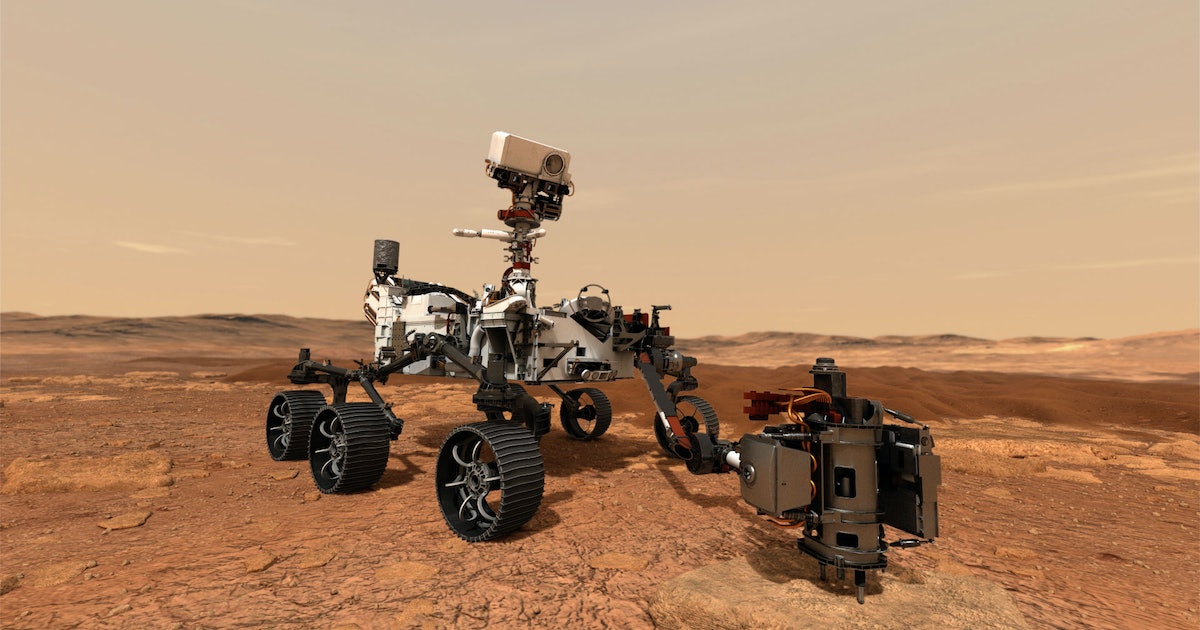
“Tantalizing” Mars rocks strengthen the idea the Red Planet once hosted life
NASA’s Perseverance rover has detected a plethora of biosignatures on Mars, the agency announced Thursday.
Now that the car-sized robot has covered 13 kilometers of Martian terrain over the span of 560 sols (days on the Red Planet), the mission team happily announced that the rover’s SHERLOC instrument detected organic material across many more samples of unique Mars rocks than first anticipated.
That news, coupled with the continued success of its companion helicopter Ingenuity, means Perseverance is off to a great start. This news comes just a year and a half after Perseverance landed on an increasingly-perplexing place called Jezero Crater, beginning NASA’s exploration of ancient Mars habitability. The recent findings lay the groundwork for the return of samples from Mars to Earth to confirm these potential signs of life.
Why it matters — Jezero Crater could be the key to unveiling, without a doubt, if Mars once harbored life.
Although its terrain lies dry and bare underneath a thin atmosphere that exposes its surface to solar and cosmic radiation, Jezero Crater was more hospitable billions of years ago.
A one-kilometer high section of the crater’s ridge appears to have given way long ago and let a flow of water through, pooling into the crater to form a lake. It brims with scientific potential, because an ancient river could have deposited material from various points on Mars into this region that Perseverance and Ingenuity cannot reach hundreds of miles away.
The bounty has provided surprising details about Mars’ history. SHERLOC scientist Sunanda Sharma said Thursday that the mission is “getting stronger and stronger clues as we move through our delta campaign.”
What they found — The rocks are “tantalizing” and “whetting our appetite for what’s next,” Lori Leshin, director of NASA’s Planetary Science Division, said on Thursday.
First, the team found evidence that the rocks are excellent at preserving biosignatures. They learned this thanks to SHERLOC, short for Scanning Habitable Environments with Raman & Luminescence for Organics & Chemicals. It performed the preliminary analysis of Perseverance’s target rocks by shooting a laser at exposed faces — called abrasion patches — to analyze the rocks’ compositions.
A closer look in a laboratory on Earth could yield definitive evidence to finally answer if Mars once harbored life, since the precious clues are neatly maintained by the clay. How these organic molecules are cemented into the rock could also reveal the age of life.
Team members also encountered another surprise. They went into the crater expecting to find sedimentary rocks, because they were looking at an ancient lake bed. But they also found igneous rocks, a sign of ancient volcanic activity on the site. While the age this volcanism took place isn’t yet known, it seems likely that, before Jezero Crater held water, it was a cauldron of lava.
NASA also pointed out that Ingenuity is exceeding its test demonstration design. It didn’t expect Ingenuity to live this long, yet it still manages to take brief jaunts into the Martian sky. NASA hopes the four-pound rotorcraft continues. Even if it soon comes to an end, the agency is thrilled that it’s provided a reliable model for how the next leg of this rock exploration could go.
The big idea — Perseverance project scientist Ken Farley emphasizes that the organic material inside these rocks are something that may have been produced by life. Other phenomena could have formed the material, though. But the concentration of organic matter they’ve found is exciting.
What’s next — NASA will instruct Perseverance to bore into more Martian rocks and store samples in steel tubes. NASA will likely send the rover to the top of the delta, a trip that will take up the next year or so of its exploration.
In the meantime, the space agency is close to picking a sample drop-off location, which should be an easy spot for a future sample retrieval mission to land.
Ingenuity’s proven design could be the springboard for newer helicopters that would pick up Perseverance’s samples with simple modifications, like the addition of wheels to scoot closer to the sample depot and grapple hooks to carry the sample tubes.
NASA is collaborating with the European Space Agency (ESA) for that next crucial leg, the Mars Sample Return (MSR). NASA expects ESA to finalize its architecture designs for the project by November of this year.
The current timeline estimates the launch of the MSR orbiter in 2027, which will head to Mars and enter an orbit around the planet. A few months later in the spring of 2028, the agencies will launch the lander that will acquire Perseverance’s samples from the ground, eventually launching a component that will ferry steel sample tubes up to the orbiter. This spacecraft will then begin the trip back to Earth, expected to arrive back here in 2033.
NASA might archive some Mars rocks for later analysis, like it did with Apollo samples. This would give time for newer technology to develop. Maybe some future innovation will finally answer that existential question: Could life exist on another planet?
NASA’s Perseverance rover has detected a plethora of biosignatures on Mars, the agency announced Thursday. Now that the car-sized robot has covered 13 kilometers of Martian terrain over the span of 560 sols (days on the Red Planet), the mission team happily announced that the rover’s SHERLOC instrument detected organic material across many more samples…
NASA’s Perseverance rover has detected a plethora of biosignatures on Mars, the agency announced Thursday. Now that the car-sized robot has covered 13 kilometers of Martian terrain over the span of 560 sols (days on the Red Planet), the mission team happily announced that the rover’s SHERLOC instrument detected organic material across many more samples…